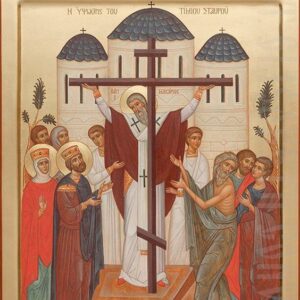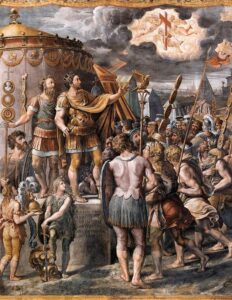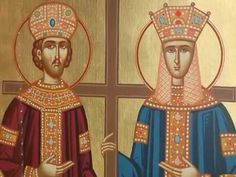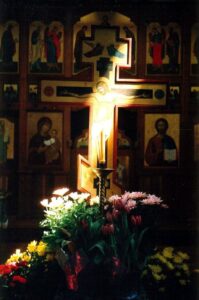The Story of the Discovery of the Cross – Sep 14

Feast of the Cross Day on September 14th is one of the important celebrations of the Orthodox Church. It is on this day that we celebrate the Exaltation and Veneration to the Precious Life-giving Cross of our Lord Jesus Christ. The Feast of the Cross like so many other liturgical feasts, had its origin at Jerusalem, where Christ shed His Blood and where Christianity took its birth. This Day relates to the commemoration of the discovery and Finding of the Cross, upon the sites of the Holy Sepulchre and Calvary.
The Holy Cross was found by Queen Helena in the AD 326. The world had forgotten about cross of Christ and the place where it was abandoned. The heathens, out of an aversion to Christianity, had concealed the place where it lay, and where our Savior was crucified. The Jews conspiring with the Roman authorities dumped Cross of Christ, in very deep pit so that it could never be found. They converted the area into a dumping ground. For almost three centuries’ continuous waste-dump made the place a hillock. Foul stink, broken glasses, thorny plants, etc made it a haven for ravens where none dared to go. They had heaped upon His sepulcher a great quantity of stones and rubbish. They had, more over, erected a statue to Jupiter in the place where our Savior rose from the dead, as we are informed by St. Jerome.
The first emperor of the Roman Empire to become a Christian was Constantine the Great. Maxentius, the neighboring king, declared war on Constantine. Constantine became deeply troubled and went to bed with a heavy heart, for Maxentius was tenfold stronger. Before the final battle, in 303, which brought him victory over his enemies and absolute rule over the entire Roman Empire, he saw a beautiful vision in the sky above the battlefield. It was a vision of the Christian Cross. Below the Cross, were the words “En Touto Nika” which means “in this sign, conquer.”

Constantine was encouraged by this sign and ordered his soldiers to prepare crosses on their armour and flags, before going to battle. He could not fully comprehend the implication of the vision nonetheless, he obeyed it in letter and spirit and miraculously he won the war against his stronger foe. Constantine’s victory was complete and decisive. He became Emperor of Rome. He had no doubt that ‘Cross’ had brought him victory. He soon believed and submitted to Jesus Christ who was hanged on the cross, died, buried and on the third day rose again. He became the first ever ruler to embrace Christianity. He made Christianity, till then a persecuted religion, the official religion of the empire. Heathen citizens became Christians, their priests became Christian priests and Heathen temples became Christian Churches. Persecutions came to a halt.
Constantine was intrigued by the vision and asked his saintly mother, Helena who was a Christian, to lead an expedition and journey to the Holy Land to search for the Cross of Jesus Christ. Helena, Constantine’s mother, also being inspired with a great desire to find the true cross on which Christ had suffered for our sins, came to Jerusalem. Although many years had passed since the Crucifixion of Christ, Helen did not lose hope of finding His Cross. She consulted all those whom she thought likely to assist her in compassing and accomplishing her pious design. The wise queen offered gold and wealth and declared rewards to those who gave information about the cross of Jesus. They informed her credibly, that if she could find out the sepulcher, she would likewise find out the instruments of the punishment. She searched diligently with her little band of soldiers for many months. The pious empress, therefore, ordered the profane building to be pulled down, the statues to be broken in pieces and the rubbish to he removed. A strange but fragrant flower was growing at the spot where they found the Cross. This flower is now called Vasiliko (Basil), which means the flower of royalty. This flower since that memorable day over 1600 years ago has been the official flower of the Orthodox Christian Church. Many Churches and clergymen use the basil leaves when blessing homes or during Church services for sprinkling the blessed water.
Finally, one bright morning on September 14th in the year 326, they discovered the holy sepulcher, and near it three crosses; also, the nails which had pierced our Saviour’s body, and the title which had been affixed to his cross ‘INRI’. These lay buried deep in the earth where Golgotha once was located. By this discovery they understood that one of the three crosses were that which they were in quest of, and that the other two belonged to the two malefactors between whom our Savior had been crucified. But as the title was found separate from the cross, a difficulty remained to distinguish which of the three was that cross on which our divine redeemer had consummated his sacrifice for the salvation of the world.

In this perplexity the holy bishop Macarius, knowing that one of the principal ladies, of the city lay extremely ill, suggested to the empress to cause the three crosses to be carried to the sick person, not doubting but God would discover which was the cross they sought for. This being done, St. Macarius prayed that God would have regard to their faith, and after his prayer, applied the crosses singly to the patient, who was immediately and perfectly recovered by the touch of one of the crosses, the other two having been tried without effect. Likewise, the three crosses were laid in turn one by one upon the dead man, who was being carried to burial. Two of the crosses had no effect, but through contact with the third cross, the dead man came to life. These miracles clearly indicated which of the three was the Holy Cross on which our Lord was crucified.

Hearing of this discovery, all the faithful desired to see the Cross of the Lord and to venerate it. The Patriarch of Jerusalem, Makarios, took the Cross onto a raised platform and lifted it on high, ‘exalting’ it, for all to see. The people fell to their knees, bowing down before the Cross and crying out repeatedly: “Lord, have mercy!”
St. Helena, full of joy for having found the treasure, which she had so earnestly sought, and so highly esteemed, that she, had a Church built over the Holy Sepulchre. To house the relic of the True Cross, built a Church on the spot, and lodged it there with great veneration, having provided an extraordinary rich case for it. The Church was consecrated on Sept. 13/14, 335. She afterward carried part of it to the emperor Constantine, then at Constantinople, who received it with great veneration: another part she sent, or rather carried to Rome to be placed in the Church which she built there, under the name of The Holy Cross of Jerusalem, where it remains to this day. The finding and exaltation of the Cross was appointed to be celebrated annually on the following day.
The title inscription (INRI) was sent by St. Helen to the same Church in Rome, and deposited on the top of an arch, where it was found in a case of lead in 1492. The inscription in Hebrew, Greek, and Latin, is in red letters, and the wood was whitened. Thus, it was in 1492 but these colors have since faded. Also, the words Jesus and ‘Iudaeorum’ are eaten away. The board is nine but must have been originally twelve inches long. The main part of the cross St. Helen enclosed in a silver shrine, and committed to the care of St. Macarius, that it might be delivered down to posterity as an object of veneration. It was accordingly kept with singular respect in the magnificent church, which she and her son built, at Jerusalem, and was shown publicly to the people at Easter. This extensive building was enclosed within the walls of Jerusalem when that city was rebuilt.

The Life-giving Cross was kept in Jerusalem until the year 614 when the Holy City fell to the Persians who looted the Church of the Resurrection and took the True Cross back with them to Persia. Fourteen years later Emperor Heraclius concluded a peace with the Persians and the Holy Cross was brought to the imperial capital of Constantinople. The Emperor, taking off his shoes and his imperial robes, carried the Cross into the Church of Holy Wisdom (Agia Sophia) where it was once again triumphantly exalted. It was then resolved that the Feast be celebrated by the Church in all parts of the world, for which reason it is called the Universal Exaltation.
The Holy Fathers of the Church, realising the many dangers of invasion in the Holy Land, decided to cut and distribute the Cross of Christ to the many great spiritual centres of Christendom. Many sections were taken to Constantinople, Mt. Athos, Alexandria, Rome and Antioch. The Cross of Jesus Christ is the symbol of Faith in the Resurrected Son of God, Jesus Christ, our Saviour and our Redeemer.

2 Comments
Prassanna John Mathew · September 12, 2022 at 8:44 am
Very informative.
Beena John · September 13, 2023 at 2:13 pm
Crucified for us. Have mercy upon us.